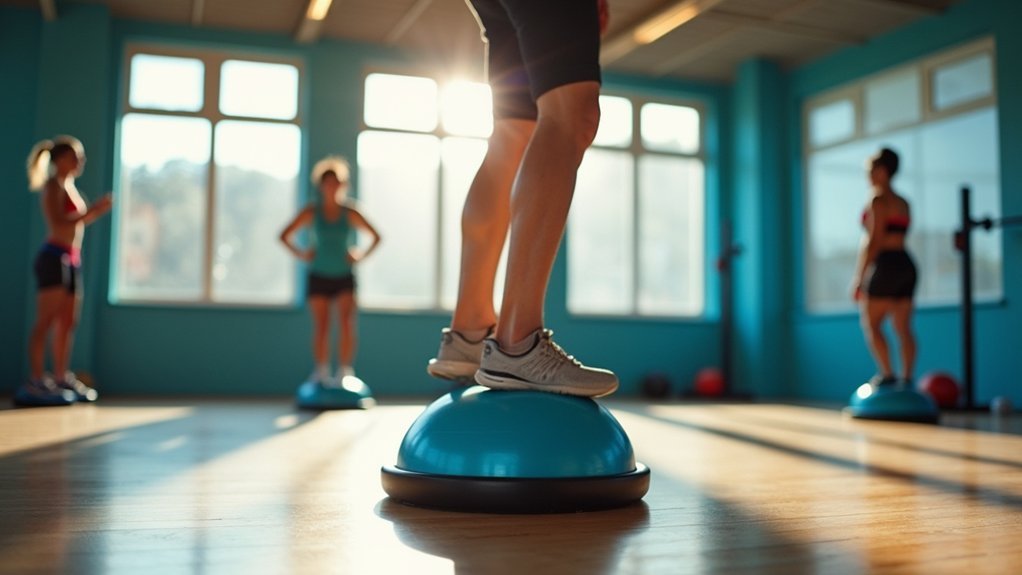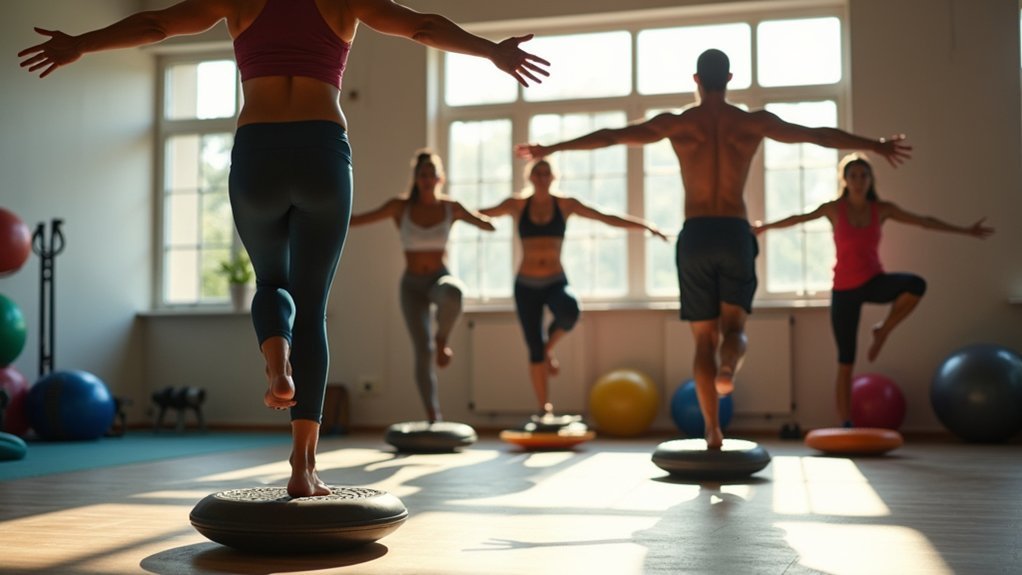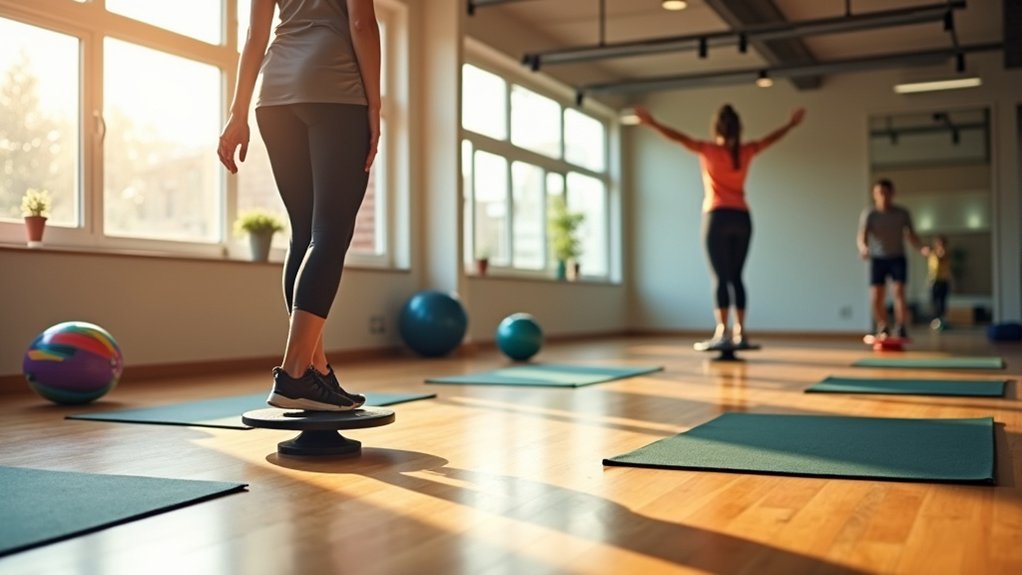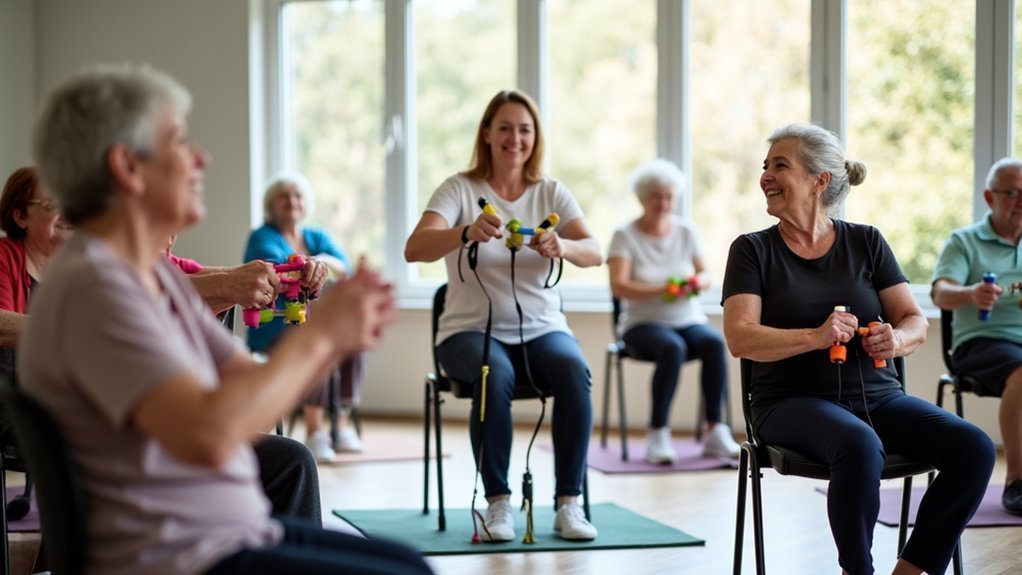The 5 best instability workouts for injury prevention include core exercises on unstable surfaces, single-leg balance drills, BOSU ball training, progressive resistance band challenges, and dynamic balance movements. You’ll strengthen deep stabilizing muscles, enhance proprioception, and build joint resilience through these focused exercises. Aim for proper form over speed or weight, and progress gradually as your stability improves. Discover how these techniques can transform your movement patterns and protect your body long-term.
Core Stability Exercises on Unstable Surfaces

When you challenge your body on unstable surfaces, you activate core muscles in markedly different ways than traditional floor exercises. These environments amplify neuromuscular activation through constant postural adjustments, engaging deeper stabilizers like the transverse abdominis and multifidi.
Try bird dog variations using basketballs under your hands or knees, or progress to cross curl-ups on foam pads. For greater challenge, perform planks or push-ups on stability trainers. The key is prioritizing control over load—external weight isn’t necessary for neural adaptations.
Challenge your core by swapping stable surfaces for balls and pads—prioritize control over load for optimal neural engagement.
You’ll benefit most from 30-minute sessions twice weekly, allowing 48 hours between workouts for adaptation. Research clearly shows that performing these exercises can improve muscle reaction time and joint protection through co-contractions.
While both stable and unstable training improve core stiffness, many find unstable exercises more engaging, potentially improving adherence to your injury prevention routine.
Single-Leg Balance Drills for Joint Protection
Single-leg balance training creates a powerful foundation for joint protection throughout your kinetic chain. This low-impact exercise engages multiple muscle groups simultaneously—from ankle stabilizers to core muscles—while enhancing proprioception and postural control.
Begin with static 30-second holds using a soft knee bend. As you progress, try marching in place or heel raises while balanced. Wall touches provide support for beginners, while closing your eyes adds difficulty for advanced practitioners. The eyes-closed variation significantly improves your spatial awareness as it forces your body to rely more on proprioceptive feedback.
For greater challenges, incorporate lateral step-downs from a small platform or “clock reaches” by tapping your free leg in different directions. Aim for 2-3 sets of 30-60 second holds per leg, 3-5 times weekly.
Start on stable surfaces before advancing to foam pads, and stop if joint pain exceeds 2/10.
BOSU Ball Training for Proprioceptive Enhancement

While traditional flat-surface exercises provide foundational strength, BOSU ball training revolutionizes proprioceptive development through its inherently unstable design. The unstable surface triggers neuromuscular adjustments, activating stabilizer muscles throughout your kinetic chain. This approach enhances body awareness through consistent challenges to your balance systems.
| Exercise | Benefit |
|---|---|
| Single-leg stance | Reduces ankle sprain risk |
| BOSU squats | Enhances knee joint stability |
| Push-up variations | Engages core reflexively |
| Lateral movements | Improves mediolateral control |
Research shows just 25-minute sessions can yield measurable stabilometric improvements. For maximum protection, progress from static holds to dynamic movements over a 6-week program. You’ll notice improved center of pressure control, enhanced reaction time, and reduced postural sway—transforming your movement quality and injury resilience across all activities.
Progressive Resistance Band Instability Challenges
Three key components elevate resistance band training beyond conventional stability work: variable tension, multi-directional resistance, and adaptable progression paths.
These elements allow you to continuously challenge your body’s stabilizing systems while minimizing joint stress.
When implementing resistance bands into your instability workouts, select appropriate tension levels that allow you to maintain proper form while still challenging your muscles.
Begin with lower resistance and gradually progress as your stability improves. Secure bands to reliable anchor points to prevent accidents and ensure effective exercise execution.
You’ll find endless exercise variations to keep workouts engaging—from standing on one leg while performing band pulls to core rotations with varied anchoring points.
Each movement simultaneously develops strength and proprioception.
Always prioritize form over resistance level, and verify you’ve properly warmed up before tackling more challenging exercises to prevent injuries rather than cause them.
Dynamic Balance Movements for Injury Resilience

Dynamic balance movements represent a critical evolution in injury prevention training by engaging multiple systems simultaneously.
These exercises strengthen your core stability while enhancing proprioception—your body’s ability to sense its position in space—creating a foundation for injury resilience.
By incorporating tools like BOSU balls and wobble boards, you’ll challenge your body on unstable surfaces, mimicking real-world situations such as walking.
This training doesn’t just prevent falls; it improves your reaction time and coordination when unexpected shifts occur.
For athletes, these movements translate directly to performance benefits, helping you adapt quickly to changing environments.
In rehabilitation settings, dynamic balance work rebuilds proprioception after injury, reducing recurrence risks.
The beauty of dynamic balance training lies in its all-encompassing approach—simultaneously addressing strength, coordination, and adaptability. Regular practice helps you maintain quality of movement rather than focusing on speed, ensuring more effective results.
Frequently Asked Questions
How Often Should I Replace My BOSU Ball for Optimal Safety?
You should replace your BOSU ball every 2-3 years with frequent use. Watch for physical damage, loss of elasticity, or permanent deformation. Don’t exceed the 136 kg weight limit for safety.
Can Instability Workouts Worsen Existing Joint Conditions?
Yes, they can worsen joint conditions if not properly controlled. You’ll risk further damage with high-magnitude instability exercises, especially with ligament laxity or OA. Stick to moderate instability and monitor joint movements carefully.
What’s the Ideal Recovery Time Between Instability Training Sessions?
Allow 48-72 hours between instability training sessions for full recovery. You’ll need this time for your muscles and nervous system to rebuild. If you’re older or training intensely, you might need additional rest days.
Are Instability Workouts Safe During Pregnancy?
Yes, you can safely do instability workouts during pregnancy with proper modifications. Focus on low-to-moderate intensity exercises, get professional supervision, and adapt as your body changes to maintain balance and prevent falls.
How Do I Modify Instability Exercises for Seniors With Limited Mobility?
You’ll need to focus on seated exercises using chairs for stability. Try chair-assisted balance holds, resistance band work, and ball-assisted core movements while maintaining proper form and starting with fewer repetitions.
In Summary
You’ve got five powerful instability training options that’ll transform your injury prevention routine. By challenging your body’s balance systems through these workouts, you’re building resilience where it counts most. Don’t wait for an injury to start—incorporate these exercises now and you’ll develop the core strength, proprioception, and joint stability that keeps you performing safely for years to come.





Leave a Reply